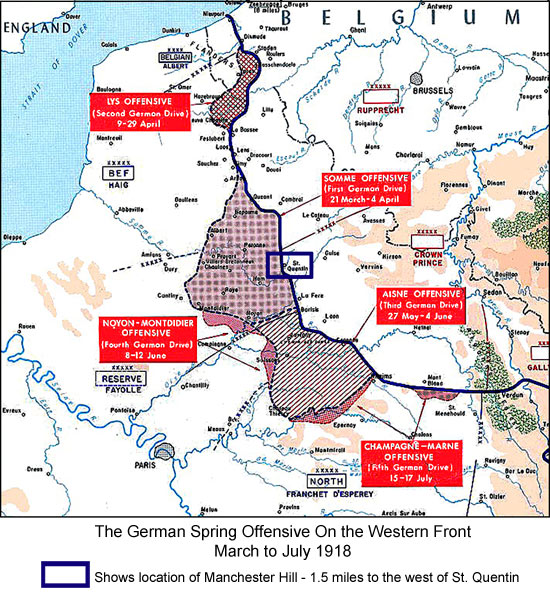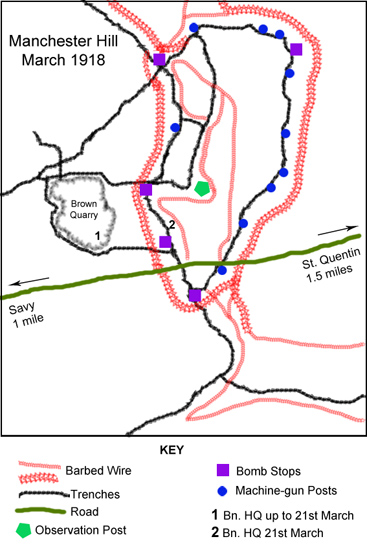
'THE GREAT WAR', 'THE WAR TO END WAR', 'WORLD WAR 1'
'What passing-bells for these who die as cattle?
- Only the monstrous anger of the guns.'
from 'Anthem for Doomed Youth'
by Wilfred Owen
The 16th(S) Battalion, Manchester Regiment The long list of important battles in WW1 is full of names familiar to most of us ... Mons, Somme, Gallipoli, Paschendaele, Cambrai ... to name just a few; and we've all heard of Gallipoli and Jutland. Even as locals we might be forgiven, for not being aware of the Battle of Manchester Hill, in 1918 (so named because in April 1917 the position had been taken from the enemy, at great cost, by the 2nd Manchesters). However, for the City of Manchester, and at least 79 families, 8 of which came from around Oldham, the centenary, in 2018, has painful significance. To go back to 1914 ... the 16th(S) Battalion of the Manchester Regiment was one of Kitchener's New Army Battalions. It was the 1st City 'Pals' Battalion and, with the 17th, 18th and 19th Manchester 'Pals', was part of the 1st City Brigade. It was formed in August 1914 and, after training, arrived in France in November 1915, with the Brigade, as part of the 30th Division. By March 1918, the Battalion was no longer comprised of just local men, as the previous two and a half years of active service, in France, had taken a substantial toll on their numbers, and was not always brought back to strength with local men. Putting Manchester Hill into context, for what was to come in 1918, we know that in December 1917, following the October Revolution, Russia agreed a ceasefire with Germany. This enabled Germany to rush back great numbers of soldiers from the Eastern Front and reinforce its army on the Western Front. In early 1918, and aware of this, the Allies expected Germany to make an all-out attack on the Western Front, with the intention of over-running a great part of France and taking key strategic areas. The Allied Command expected the offensive to be sooner rather than later, and were conscious of the fact that they had to hold on at all costs until American reinforcements could arrive in numbers significant enough to make a difference to the outcome. The German command also knew this and realised that it might be their last chance to gain control of key areas. To counter the anticipated attack, the greatly overstretched allied line relied on a series of forward positions incorporating strongly defended redoubts, within a defensive area surrounded by a continuous belt of barbed wire, and covered by observation posts. The main line of allied defence was about a mile further back and the aim was to break up the attacking wave of enemy troops, and create as much havoc and disorder as possible, before they reached the main allied battle zone.
Initially, the planned offensive was successful, breaking through the allied lines and sweeping into France, although with heavy casualties sustained on both sides.
and
The Battalion was deployed as follows: Critically, the weather would play a devastating part in the events of that day, the first of the German Spring Offensive. All was quiet during the clear, moonlit night before the attack but, at 6:30am, the Germans began artillery bombardment of the Allied position. Disastrously, by this time, the valleys overlooked by the Manchester Hill machine gun posts, were shrouded in thick morning fog giving the enemy soldiers all the cover they would need. At 7:30 there still appeared to be no troop movement from the enemy lines and the German shells were landing behind the allied sectors. Just after 8am the bombardment increased, destroying some internal communication telephone lines on the Hill. At 8:30 came the first news that the attack had started ... that 'A' Company HQ, and then 'B' Company HQ, were practically surrounded. The thick fog had given the attackers all the help they needed to approach completely unseen ... but the defenders were not prepared to surrender until all hope was lost ... they could disrupt the German advance even if they couldn't halt it. At 9am came the news that the soldiers on the left flank of the redoubt were fighting "at close quarters with the enemy", and was repeated again in respect of the right flank. Desperate fighting raged on, as the fog lifted in the late morning, and the enemy could be seen breaking through the line on both sides of the Hill, isolating it, and leaving enough troopers behind to "settle with Manchester Hill" But the defenders would not capitulate ... led by Col. Elstob, and surrounded, they fought against tremendous odds as every man in the redoubt rallied around the Colonel. He was already the holder of the M.C. and D.S.C. and, despite being injured 3 times, continued to lead them until he was shot, and killed instantly, in the late afternoon. The remnants of the garrison in the redoubt, wounded, exhausted and now leaderless, surrendered.
Lt. Col. Elstob was awarded the Victoria Cross, posthumously, in 1919. His body was never recovered and, as with a number of others who fought alongside him and whose bodies were not recovered, he is remembered on the Pozieres Memorial. His citation for the Victoria Cross reads :
The 79 men of the 16th Manchesters who died on Manchester Hill are listed on the MLFHS website : HERE Pt. 39652 Ernest Armitage, 16 Beech St., Oldham ~~~~~~~~~~~~~~~~~~~~~~~~~~~~~~~~~~~~~~~~~~~~~~ * Museum of the Manchester Regiment - The Men Behind the Medals with Wilfrith Elstob's V.C. citation HERE Contributed by Sheila Goodyear |
If you have Oldham and District items that we can include on our website, PLEASE visit the information page to find out how you can help.

